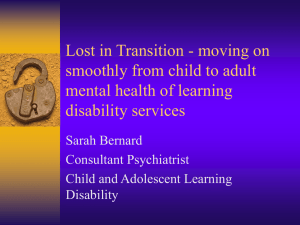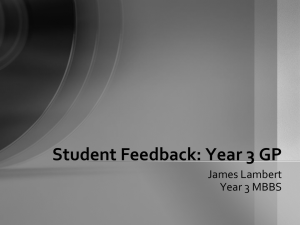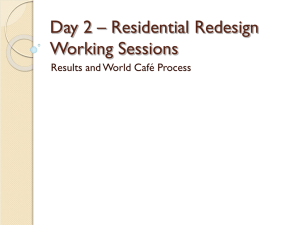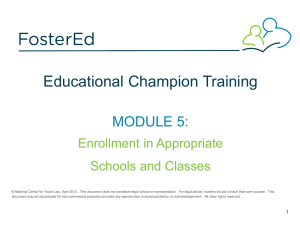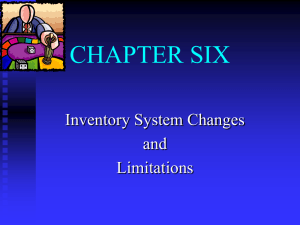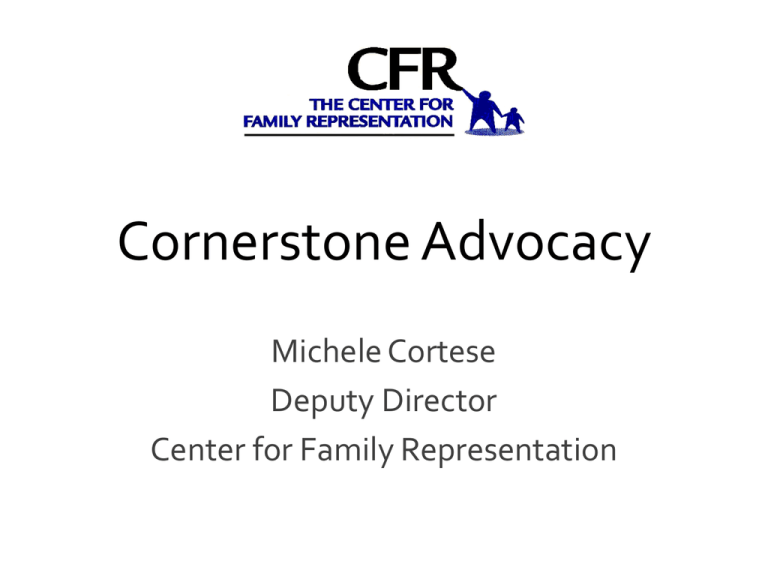
Cornerstone Advocacy
Michele Cortese
Deputy Director
Center for Family Representation
The Four Cornerstones
Placement
Visiting
Should be as frequent and long as possible, and in
settings that most closely mimic family life.
Should support a child’s connections to family and
the people and institutions that the child was
connected to before placement.
“Cornerstone Advocacy”
supports family
reunification by devoting
intensive advocacy during
the first 60 days of a case
in four areas.
Services
Conferences
Should address a parent and child’s strengths and
needs.
Should occur out of court and provide opportunities
for parents and older youth to meaningfully
participate in their case planning.
Cornerstone Results
--An median length of foster care stay of 57 days
compared to a city wide average of 11.5 months
(and 4 vs. 29 months statewide)
--a dismissal rate of 33% in 2009 compared to
11% in the year prior to CFR taking court
assignments
--cost of CFR team: $5900 over the life of the
case; lowest cost of foster care: $27K per child per
year
Why 60 Days?
The 60th day is a best
practices benchmark for
the trial phase of a
dependency case to be
complete.
To take advantage of
the sense of urgency
and optimism at the
beginning of the case
To set the direction of
the case towards
reunification from the
outset.
While Cornerstone Advocacy should begin on day one, it can and should
continue throughout the case, regardless of when a trial date is set.
The First Cornerstone: Placement
Appropriate
placement eases the
child’s transition to
foster care
• A placement that helps
children stay connected to
teachers, friends, and other
community supports like
therapists or physicians
minimizes the disruption in
a child’s life.
Appropriate
placement keeps
parents engaged
Appropriate
placement supports
reunification
• Foster parents who are
willing to support a parent
and child’s relationship play
a critical role in maintaining
family ties that inspire
parents to stay engaged in
services.
• A placement which
appropriately supports a
child’s connection to
family promotes
reunification and eases
the transition home.
The Second Cornerstone: Services
Poor or Inappropriate
Services
Creative and flexible
services
may be ill-suited to the family and may create unnecessary
demands on a parent who must attend programs, court
appearances, and visits; may not adequately address children’s
needs creating additional obstacles to healthy healing and
reunification
will keep parents engaged by ensuring that the
services are meaningful and manageable given
the parents’ other commitments
may lose legitimacy for parents and can cause
them to disengage or “fail to comply.”
will move the family towards reunification more
quickly by addressing their needs and building
on their strengths
The Third Cornerstone: Conferences
Many important decisions about a
family’s life are made outside court in
family conferences.
•Will the family remain together?
•Will a family member become a foster parent?
•How often will the parent and child visit each
week?
•Is the family ready for unsupervised visits?
However, historically there has been a
disconnect between the social work sphere and
the legal sphere.
•An attorney who is not aware of decisions made at a family
conference may have inaccurate information or be unaware
of issues arising from these conferences. Parents and Youth
may feel disrespected or unsupported or confused, leading
to unproductive relationships with agency workers and
foster parents.
The Fourth Cornerstone: Visiting
Visiting is the key
to parent
engagement
Visiting helps
children cope
with foster care
and eventually
with the
transition home
• Visiting enables parents to continue the
relationship with their children and
inspires them to keep working on getting
them home.
• When children can see their parents
often and in circumstances that
make them comfortable, they can
talk with the people they most
often need to about what has
happened—their parents.
• Quality visiting can help children
preserve cherished rituals, share
stories from school and social life,
and continue to seek advice and
encouragement from their parents.
Meaningful and
frequent visitation
is the single best
predictor of safe
and lasting
reunification
• Practitioners should
advocate for more frequent
visits with as little
supervision as necessary.
• When possible, visits should
occur outside the agency
and include activities that
mimic family life.
The Legal Basis
for Cornerstone Advocacy
“Reasonable efforts”
• The passage of ASFA prompted a renewed focus on the agency’s
duty to make reasonable efforts to safely reunify families. Think
about how the Cornerstone applications can fairly be deemed
‘reasonable efforts’ in support of reunification.
State dependency
statutes
• These address services and assistance. Also look to any issuespecific sections of your state statute (i.e. the portion that deals
with services, visits, or placement). Argue that your advocacy fulfills
the spirit if not the letter of that section.
State Regulations
• These detail the obligations that agencies owe parents and
children. For example, most states have regulations which include
specific agency obligations regarding visits, conferences and
services, and placement.
Administrative directives,
memos, and guidelines
• Find these on state and county Web sites. While not law per se, they
typically represent social service providers’ interpretation of best
practices and legal obligations and thus can be persuasive in
convincing an agency or a judge to move on a Cornerstone issue.
Cornerstone Advocacy: Legal ArchitecturePennsylvania
“Reasonable Efforts” language
i.e., 23 Pa.C.S.A.6373; 42 Pa.C.S.A 6351
-plusAny statutory section that is applicable (procedural posture may be
important) i.e., 23 Pa.C.S.A. 6375 (services);
-plusApplicable Regulations (Chapter 55 of the admin. Code)
-plusAny Policy or Practice Directive or Guideline
Example:
Application for Child to be Placed with a God Parent so that She can Remain in her
School
23 Pa.C.S.A. Section 6373(a) (4)
[General Protective Services Responsibilities include] providing temporary substitute
placement…for a child in need of care…
-plus55 Pa.Code 3130.67 (2) (iv) and (7) (ii)
[Family service plan must include] Assurances that the child’s placement in foster care takes
into account proximity to the school in which the child is enrolled at the time of
placement…how the location….is in proximity to the child’s home and will serve to
encourage visiting between the child and parents….
OCYF Bulletin 00-03-03
Kinship foster parent can be anyone with a “significant positive relationship” (p. 7)
-andOCYF Bulletin 3140-04-05
The Court has the authority to order specific placement
-andPennsylvania Child Welfare Values & Principles
We will maintain and promote lifelong connections
We believe every community has strengths and resources for children, youth, and families
“Litigating” the Cornerstone Application to have a child placed with a god
parent and thus remain in her school
Remember: You rarely have to have an extensive hearing to make a good record and/or be
persuasive on a Cornerstone application—
think “mini litigation.” (i.e. asking a few questions on the record of a parent, caseworker, or
interested party or handing in a report)
And Remember…..SHOW AND TELL is the rule of thumb when raising any
Cornerstone issue: you may have to provide copies of regulations and/or
Policy letters or Administrative Directives to convince the Agency or Judge
Oral Application:
•Argue that helping your client remain in her school should be deemed a “reasonable effort” in
support of reunification and in support of your client’s emotional health in that child will adjust
better to foster care if she can stay among familiar teachers and peers, remain in any established
school services, sports or clubs AND that future reunification will not be delayed due to the desire
to preserve a school placement until the end of the academic year (as is so often the case)
•Argue that application regulations make clear that “kin” are those with a family like relationship so
a god parent qualifies
•Present brief testimony on this issue, i.e. have the god mother present to tell the court under oath
about her relationship; have the parent tell the court about the relationship; (this takes only a few
minutes and makes the record)
•Show and Tell: hand up copies of the applicable regulations and bulletins
Motion or OTSC:
Argue as stated above;
Attach: applicable reg; agency letter, affidavit of the god parent or your own affirmation
indicating that you have spoken with the god parent and/or the parent about the
relationship; provide detail about the history between the child and the god parent.
**In the situation of either papers or an oral application, if the court is unwilling to order
the agency to place the child with the god parent, ask that the agency “explore and
report” back in a short time frame; often an agency does not want to come back to court
just to say ‘no.’ (explore and report can really work!)
Example: Application for Visit Host
23 Pa.C.S.A. 6373 (b)
In its effort to assist the child and the child’s parents…..the county agency will make reasonable
efforts to ….make it possible for the child to return to home….
(a)
-plus55 Pa. Code § 3130.68
The county agency shall provide opportunity for visits between the child and parents as frequently as
possible but no less frequently than once every 2 weeks at a time and place convenient to the parties
and in a location that will permit natural interaction…..
-plusPA Dept. of Public Welfare Office of Children Youth and Families Visitation Handbook 1999:
p. 23-25:…. “Others, such as extended family members, private agency caseworkers, and other service
providers may also have information and responsibilities that warrant their participation in developing the visit
plan. …Visits should be located in the parents’ home unless there are specific reasons not to do so. The
location of visits should permit privacy and interaction and be only as restrictive as required to protect the
child(ren). Visit locations may include the parents’ home, the foster parents’ home, parks, restaurants, family
centers, recreational activities, the barber shop, school events, locations of family rituals or celebrations - the
list is endless. …In many instances, effective visiting is undermined by both the agency’s and the parents’
lack of resources. Therefore, the identification of services and resources that will support children and
parents in following through with the visit plan is necessary. These may include tokens for transportation,
provision of transportation, a visit supervisor with skills to assist the family in managing the visit interactions,
and assistance with planning meals when children are home for lengthy visits.
“Litigating” the Application for a Visit Host
Oral Application
Argue: Providing a means for your client to see her siblings or parent or other significant people is a “reasonable
effort” in support of reunification and promotes her health and well being in that current minimum practice only
permits her to see her parents the equivalent of one day per year and more frequent visits that are fun,
supportive and mimic family life are more likely to help her maintain her attachments and “permit natural
interaction.” (55 Pa.Code 3130.68)
Argue: Pennsylvania Standards for Child Welfare suggest visits should be at least weekly (p. 29) and that
routine child care activities to support parent/child bond (p. 29)
Argue: that Pennsylvania has recognized that better visiting plays a key role in safe reunification, that
visiting should be organized around typical parenting events, that extended family and community
members have a role to play in service planning and that ‘informal’ resources should be explored in
promoting meaningful visiting. (See, PA Child Welfare Values and Principles, 1/09, Child Welfare
Standards, PDPW-OCYF Visitation Handbook, pp. 11-14; pp. 23-25 )
Argue: that your client should not be compromised or deprived of the benefit of the law and recognized
best practices because of scarce resources; visit hosts are win-win;
Show and Tell: bring copies of the applicable policy materials; have the proposed Visit Host come to
court to meet the judge; ask that at least the proposed visit host be invited to any upcoming agency
conference, attend a visit with the parent, and be investigated; ask the agency to “explore and report”
on the next (short) court date; note: in NYC, the investigation has never amounted to more than a state
registry clearance ; if your proposed visit host is a mandated reporter under state law, highlight thatl
Motion or OTSC
Argue: as above;
Attach: applicable regulations and excerpts form CDHS report; affidavit
from proposed visit host;
Other Visiting Steps to take: convene a meeting of relevant stakeholders to
discuss how to improve visits, what might be applicable guidelines for visit
hosts, etc; cultivating relationships in this area helps move practice.
Great PA Cornerstone Regs and Policy Statements:
Placement:
55 Pa. Code 3130.71 (re: Placement reviews): county must petition at least every six months to have
child’s placement status reviewed when in care by order of the court OR have administrative review;
parents entitled to have representative attend and parents and their attorneys to be given 15 days prior
notice when placement review is done by administrative meeting
55 Pa. Code 3130.67 placement shall take into account proximity to school, proximity to parents in order
to encourage visiting, and any known medical, psychological, etc. needs.
OCYF Bulletin 00-03-03 Kinship foster parent can be anyone with a “significant positive relationship” (p. 7)
OCYF Bulletin 3140-04-05 The Court has the authority to order specific placement
Pennsylvania Child Welfare Values & Principles (Jan 09)We will ensure community connections are
maintained and all work with children, youth, and families is developmentally appropriate
Services:
55 Pa. Code 3130.35 specific services outlined as “reunification services”
Pennsylvania Child Welfare Values & Principles (Jan 09) We will continue to pursue cultural competence
for our work with children, youth, and families and ensure services are culturally relevant
Conferences:
55 Pa. Code 3130.71 (re: Placement reviews); parents entitled to have representative attend and parents and
their attorneys to be given 15 days prior notice when placement review is done by administrative meeting
55 Pa. Code 3130.61 (Family service plans) ….services identified within 60 days
University of Pittsburg PA Family Group Decision Making Model: (40 out of 67 counties participating)
(http://www.pacwcbt.pitt.edu/FGDM_Resources.htm.) p. 4-6: extended family, friends, community
members and service providers should be invited
Pennsylvania Child Welfare Values & Principles (Jan 09)—
We believe all challenges have solutions grounded in family and community strengths
We believe every community has strengths and resources for children, youth, and families
We believe children, youth, and families are best served by a system that demonstrates a
commitment to teamwork through inclusion and meaningful collaboration
PA Dept. of Public Welfare Office of Children Youth and Families Visitation Handbook 1999:
p. 25For every child placed in foster care, there is a team providing service and support to the child
and the child’s family. As will be further discussed in chapter 5, cooperating with and assisting others
toward a common purpose enhances each team member’s effectiveness. Sometimes, the team
members do not formalize their collaboration. However, meeting regularly as a team not only
strengthens the assessment, service planning and implementation, and decision-making over time, it
also provides support for each team member. Typically, the team includes the foster parents, the
child’s parents, the child (depending on age and developmental stage), the public agency
caseworker, a private agency caseworker (where applicable), and others (when invited), such as
extended family members, mental health professionals, and other social service professionals.
Visiting:
55 Pa. Code § 3130.68
(a) The county agency shall provide opportunity for visits between the child and parents as frequently as
possible but no less frequently than once every 2 weeks at a time and place convenient to the parties
and in a location that will permit natural interaction…..
55 Pa. Code § 3130.68
(c) If visitation between parents and their child in placement is cancelled by the county agency, the county
agency shall do one of the following:
(1) Schedule a make-up visit if the cancellation results in less than two visits per month. The county
agency is not required to but may schedule make-up visits if the reason for the cancellation was the
parent's decision not to attend an agreed upon visit unless a valid excuse was provided at least 48 hours
in advance.
(2) Schedule either a make-up visit or reasonable additional visitation if the parents receive more than two
visits per month. (not required if parent cancelled without 48 hour notice and “valid” excuse
(d)The county…shall provide for ….visits in all cases in which the child’s initial placement location has
been changed and the change…makes visitation a hardship on the parent…
PA Dept. of Public Welfare Office of Children Youth and Families Visitation Handbook 1999:
pp. 11-14: It is ….essential that agencies develop policies, programs, and practice approaches that
promote and support frequent parent-child visiting. …..
Over the past three decades, a growing body of research has soundly established several major findings
related to visiting between children in care and their parents. Study findings indicate that frequent regular
visiting:
• enhances children’s emotional well-being and adjustment while in care,
• improves parents’ positive feelings about the placement and decreases their worries about their children
while they are in care, and
• is strongly correlated with achieving the placement outcome of reunification, achieving other
permanency planning outcomes (i.e. adoption, guardianship, or long-term foster care), and decreasing
time in care.
Research also indicates that a specific written plan for visits increases the likelihood that parents will visit.
p. 24: The first visit should occur within three days of placement, but no later than one week of
placement. Weekly visits should be viewed as a minimum frequency, rather than as the ideal or standard.
Visit frequency should reflect the needs of the children and their parents, and the service objectives. For
example, a visit more often than once a week may be important for very young children.
p. 25: In many instances, effective visiting is undermined by both the agency’s and the parents’ lack of
resources. Therefore, the identification of services and resources that will support children and parents in
following through with the visit plan is necessary.
p. 32: Creative visiting plans reflect attention to the family’s traditions, culture, and ways of celebrating
milestones, such as birthdays. Creative plans acknowledge the broad range of activities that parents and
children might participate in together, including attending school conferences, open houses, and other
school events; attending required appointments, such as medical appointments; shopping for clothes and
other necessities; and learning new ways of being together, such as participating in classes for parents
and children at the library or the YM/YWCA. Creative visits will provide opportunities to assist family
members in developing new skills that will support them in their ongoing individual and family
development.
p. 94: “The focus when a child is first placed needs to be…one of immediate and intensive reunification
efforts, which include frequent, high quality visiting.”
Resources
Center for Family
Representation
212-691-0950
www.cfrny.org
info@cfrny.org
University of Pittsburgh Family Group
Decision Making Model
www.pacwcbt.pitt.edu
/FGDM_Resources.htm.
Annie E. Casey Foundation
www.aecf.org
National Center for Family
Permanency and
Connections
www.hunter.edu/socwork/nr
cfccp
Administration on Children,
Youth and Families
National Project to Improve
Representation for Parents
Involved in the Child Welfare
System
www.childwelfare.gov
/info@childwelfare.gov
www.abanet.org/child/parent
representation/home.html
Children’s Bureau
These materials were made possible, in
part, through the generous support of the
Sirus Fund. The views expressed here are
those of CFR and are not attributable to
the Fund. All rights reserved 2010.
Special Thanks to:
Marize Ayob, Lauren Judy, Marissa Nardi,
Casey Reichanadter
Legal Interns Summer 2010
For more information
Contact Michele Cortese at
mcortese@cfrny.org

